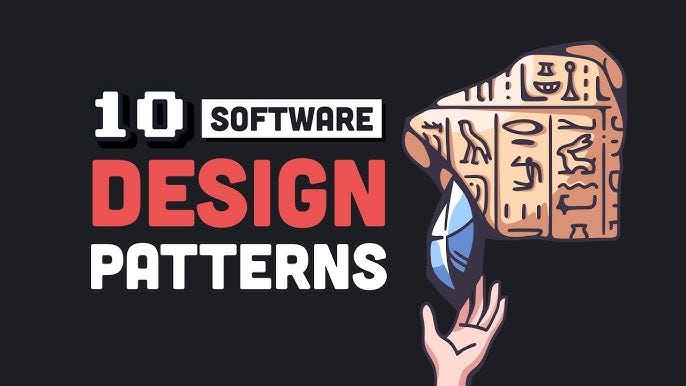🎨 Design Patterns Demystified: The Blueprint Every Developer Should Know!
🎨 Design Patterns Demystified: The Blueprint Every Developer Should Know!
If you’re a software developer who dreams of writing cleaner, reusable, and scalable code, Design Patterns are your ultimate weapon! 🛠️ Whether you’re building an enterprise-grade backend or a snappy frontend app, these time-tested solutions to common programming problems can transform your code from messy to masterful. 🧠✨

Let’s dive deep into the Top 10 Must-Know Design Patterns with examples, features, and best use cases! 🚀
1️⃣ Singleton Pattern — 👑 “One to Rule Them All”
💡 Purpose: Ensure a class has only one instance and provide a global point of access.
✅ Features:
- Lazily loaded
- Thread-safe (with proper implementation)
- Reduces memory footprint
📦 Example (in Python):
class Singleton:
_instance = None
def __new__(cls):
if cls._instance is None:
cls._instance = super().__new__(cls)
return cls._instance🔥 Best Use Case:
- Configuration Manager
- Database Connection Pool
- Logger Utility
2️⃣ Factory Method — 🏭 “Create Without Revealing”
💡 Purpose: Define an interface for creating an object, but let subclasses decide which class to instantiate.
✅ Features:
- Encapsulates object creation
- Promotes loose coupling
- Adheres to Open/Closed Principle
📦 Example:
class Animal:
def speak(self): pass
class Dog(Animal):
def speak(self): return "Woof!"
class AnimalFactory:
def create_animal(self, type):
if type == "dog":
return Dog()🔥 Best Use Case:
- When the exact class to instantiate isn’t known in advance
- Plugin architectures
3️⃣ Observer Pattern — 👀 “Tell Me When It Changes”
💡 Purpose: Establish a one-to-many relationship so when one object changes, others are notified automatically.
✅ Features:
- Promotes loose coupling
- Supports event-driven programming
📦 Example:
class Subject:
def __init__(self):
self._observers = []
def attach(self, obs):
self._observers.append(obs)
def notify(self):
for obs in self._observers:
obs.update()🔥 Best Use Case:
- UI frameworks (e.g., React’s state update)
- Event listeners
4️⃣ Strategy Pattern — 🧠 “Choose Your Behavior”
💡 Purpose: Define a family of algorithms, encapsulate each one, and make them interchangeable at runtime.
✅ Features:
- Clean separation of concerns
- Avoids long conditional statements
📦 Example:
class PaymentStrategy:
def pay(self, amount): pass
class CreditCard(PaymentStrategy):
def pay(self, amount): print(f"Paid {amount} via Credit Card")
class PayPal(PaymentStrategy):
def pay(self, amount): print(f"Paid {amount} via PayPal")🔥 Best Use Case:
- Payment processing
- AI/ML where models are swappable
5️⃣ Decorator Pattern — 🎁 “Wrap It with Power”
💡 Purpose: Add responsibilities to objects dynamically without altering the structure.
✅ Features:
- Promotes flexible code
- Adheres to Single Responsibility Principle
📦 Example:
def bold(func):
def wrapper():
return "<b>" + func() + "</b>"
return wrapper
@bold
def text():
return "Hello"🔥 Best Use Case:
- UI rendering elements
- Logging, access control, and performance measuring
6️⃣ Adapter Pattern — 🔌 “Plug and Play”
💡 Purpose: Convert the interface of a class into another interface clients expect.
✅ Features:
- Improves code reusability
- Acts like a bridge between incompatible interfaces
📦 Example:
class EuropeanPlug:
def connect(self): return "220V connected"
class Adapter:
def __init__(self, plug):
self.plug = plug
def connect_us(self):
return self.plug.connect() + " with Adapter"🔥 Best Use Case:
- Integrating legacy code
- Connecting APIs with different contracts
7️⃣ Command Pattern — 📦 “Encapsulate Requests”
💡 Purpose: Turn a request into a stand-alone object that contains all information about the request.
✅ Features:
- Supports undo/redo
- Decouples sender and receiver
📦 Example:
class Light:
def on(self): print("Light ON")
def off(self): print("Light OFF")
class LightOnCommand:
def __init__(self, light): self.light = light
def execute(self): self.light.on()🔥 Best Use Case:
- Task queue systems
- GUI command operations
8️⃣ Prototype Pattern — 🧬 “Clone It!”
💡 Purpose: Create new objects by copying an existing object, known as the prototype.
✅ Features:
- Reduces cost of object creation
- Great for performance
📦 Example:
import copy
class Car:
def __init__(self, model): self.model = model
def clone(self): return copy.deepcopy(self)🔥 Best Use Case:
- Game development
- Object-heavy simulations
9️⃣ Builder Pattern — 🏗️ “Step-by-Step Construction”
💡 Purpose: Separate the construction of a complex object from its representation.
✅ Features:
- Improves readability
- Great for constructing hierarchical objects
📦 Example:
class BurgerBuilder:
def __init__(self): self.burger = []
def add_cheese(self): self.burger.append("Cheese"); return self
def add_patty(self): self.burger.append("Patty"); return self
def build(self): return self.burger🔥 Best Use Case:
- HTML builders
- Complex document or report generators
🔟 Chain of Responsibility — 🔗 “Pass the Request Along”
💡 Purpose: Pass requests along a chain of handlers until someone handles it.
✅ Features:
- Reduces coupling between sender and receiver
- Adds flexibility
📦 Example:
class Handler:
def __init__(self, next=None): self.next = next
def handle(self, request):
if self.next: return self.next.handle(request)🔥 Best Use Case:
- Support systems (e.g., tiered customer support)
- Middleware in web frameworks
🔚 Conclusion: Why Learn Design Patterns?
💭 Whether you’re a junior dev or a senior architect, design patterns give your code:
- 🧩 Structure
- 🔁 Reusability
- 🔍 Readability
- ⚙️ Flexibility
📚 “Design patterns are solutions to recurring problems — not code to copy, but principles to apply.”
📢 Bonus Tip:
👉 Read “Head First Design Patterns” and “Design Patterns: Elements of Reusable Object-Oriented Software” for deeper understanding.
Comments
Post a Comment